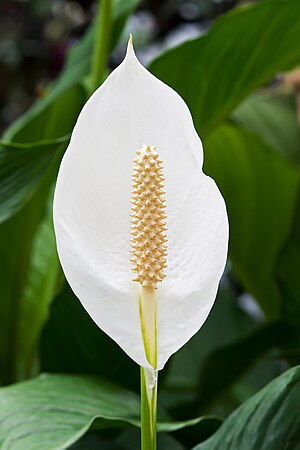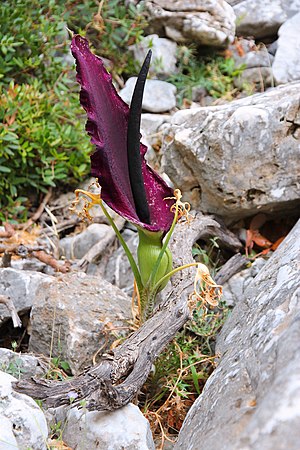Category:Araceae
| Araceae | |
|---|---|

| |
| Inflorescence of Xanthosoma sagittifolium | |
| Scientific classification | |
| Kingdom: | Plantae |
| Clade: | Angiosperms |
| Clade: | Monocots |
| Order: | Alismatales |
| Family: | Araceae Juss.[2] |
| Genera | |

The Araceae are a family of monocotyledonous flowering plants in which flowers are borne on a type of inflorescence called a spadix. The spadix is usually accompanied by, and sometimes partially enclosed in, a spathe or leaf-like bract. Also known as the arum family, members are often colloquially known as aroids. This family of 114 genera and about 3750 known species[3] is most diverse in the New World tropics, although also distributed in the Old World tropics and northern temperate regions.
Food plants in the Araceae include Colocasia esculenta (taro, dasheen), Xanthosoma (cocoyam, tannia), and Monstera deliciosa (Mexican breadfruit). While the aroids are little traded, and overlooked by plant breeders to the extent that the Crop Trust calls them "orphan crops", they are widely grown and are important in subsistence agriculture and in local markets. The main food product is the corm, which is high in starch; leaves and flowers also find culinary use.
References
- ↑ Bogner, Josef; Johnson, Kirk R.; Kvacek, Zlatko; Upchurch, Garland R. Jr (2007). "New fossil leaves of Araceae from the Late Cretaceous and Paleogene of western North America". Zitteliana. 47: 133–147.
- ↑ Angiosperm Phylogeny Group (2009), "An update of the Angiosperm Phylogeny Group classification for the orders and families of flowering plants: APG III", Botanical Journal of the Linnean Society, 161 (2): 105–121, doi:10.1111/j.1095-8339.2009.00996.x, retrieved 2010-12-10
- ↑ Christenhusz, M. J. M. & Byng, J. W. (2016). "The number of known plants species in the world and its annual increase". Phytotaxa. Magnolia Press. 261 (3): 201–217. doi:10.11646/phytotaxa.261.3.1.
Acknowledgements
This article uses material from the Wikipedia article Araceae, which is released under the Creative Commons Attribution-Share-Alike License 3.0.
Pages in category "Araceae"
The following 17 pages are in this category, out of 17 total.
